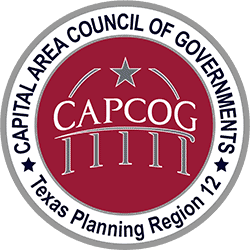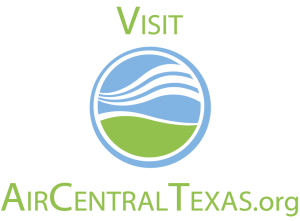Home » Divisions » Regional Planning & Services » Air Quality
Air Quality
CAPCOG’s Air Quality Program coordinates regional air quality planning and performs air quality technical research focusing on ground-level ozone and particulate matter pollution.
The program’s planning efforts include coordinating the development and implementation of voluntary regional air quality plans, providing technical assistance to organizations that participate in the air quality plans, administering regional pollution reduction grants, and conducting air quality education and outreach to reduce emissions and exposure to air pollution.
Technical research efforts include air quality monitoring, emissions inventory development, data analysis, modeling, and pollution control strategy evaluation. The program is funded by Texas Commission on Environmental Quality grants and local communities. The program also supports the CAPCOG policy board, the Clean Air Coalition (CAC).
Regional Air Quality Plan
The 2019-2023 Regional Air Quality Plan is designed to help keep Central Texas’ air clean. The regional plan serves as a guide to maintain and improve outdoor air quality; reduce the impact of emissions; and mitigate health, environmental, economic and social impacts of regional air pollution.
The plan’s two key objectives are:
- to maximizing the probability of compliance with the National Ambient Air Quality Standards (NAAQS) region-wide; and
- minimizing health and environmental impacts of regional air pollution.
To achieve these objectives, the plan calls to:
- Implement controls on nitrogen oxides (NOx) emissions
- Conduct outreach, educate, and provide technical support to enhance NOx emission reductions
- Do outreach and education when air pollutants are high enough to be considered moderate or worse on the EPA’s Air Quality Index.
- Monitor ambient air
- Research and plan other air quality activities
- Advocate policy
Thirty-nine entities, including CAC members and other participating organizations, made tiered commitments to help protect air quality before the adoption of the plan.
Plan Addendum
The Clean Air Coalition updated the Regional Air Quality Plan in November 2021 to address particulate matter (PM) pollution which can be harmful to people’s health. The updates include several measures local governments, CAPCOG, and other organizations have made to cut PM pollution and increase awareness of high short-term PM levels when they occur. These steps should help reduce PM exposure within the region.
Monitoring & Reporting
Continuous Air Monitoring Stations (CAMS) collects data on pollution concentrations and meteorological conditions. CAPCOG and other organizations can use this data to determine compliance with air quality standards, validate air pollution modeling, measure air quality upwind and downwind of a particular source or area, track air quality trends, and notify the public of unhealthy air pollution levels, among other uses.
2019-2023 Ozone Monitoring Network Review Report
To collect the data, CAPCOG operates eight continuous air quality monitors throughout the region, which provide supplement data to the four regulatory monitoring stations operated by TCEQ. CAPCOG’s monitoring contractors follow detailed quality assurance project plans to ensure a high level of data accuracy.
Annual Air Quality Report
Each ozone season, CAPCOG uses the monitoring data and prepares an annual report detailing the status of air quality in the Austin-Round Rock-Georgetown Metropolitan Statistical Area. The report also evaluates the contribution to the region’s high Ozone days and summarizes the status of emission reduction measures.
Other Monitoring Projects & Reports
In addition to operating the continuous stationary air quality monitors, CAPCOG has done several projects to collect air pollution data and analyze it for air quality planning purposes, including temporary monitoring, surface mobile monitoring, aircraft-based monitoring, and discrete VOC canister sampling. Such information can be used to research potential new continuous monitoring station locations, measure pollution levels in areas not covered by existing monitors, measure impacts of particular source areas, measure the contribution of urban emissions on rural areas, determine trends in the composition of volatile organic compounds in the atmosphere and more.
Air Quality Public Outreach & Education
CAPCOG manages the Air Central Texas (ACT) initiative, a public education outreach campaign that seeks to reduce exposure to air pollution in Bastrop, Caldwell, Hays, Travis, and Williamson counties. The campaign educates people and organizations about taking voluntary actions that decrease emissions and help the public to avoid exposure to high pollution levels when they occur. Through Air Central Texas, CAPCOG and its partners provide the public with information about Central Texas air quality, support existing air quality programs, and motivate the public to “Be Air Aware” when making their daily decisions.
National Air Quality Awareness Week
National Air Quality Awareness Week is always the first week in May and is spearhead by the National Oceanic and Atmospheric Administration (NOAA) – National Weather Service, Centers for Disease Control and Prevention (CDC), U.S. Forest Service, National Aeronautics and Space Administration (NASA), and U.S. Department of State – Environmental Protection Agency. The week promotes events that increase air quality awareness and encourage people to check the Air Quality Index (AQI) daily. The CAPCOG Air Quality Program traditionally coordinates a week-long social media campaign with the CAC partners to raise awareness of air quality throughout the region.
Review a previous CAPCOG National Air Quality Awareness Week proclamation.
Air Quality Grants
CAPCOG maintains a list of air quality related grants for various regional stakeholders — governments, nonprofits, business and even individuals. In some cases, CAPCOG can assist a partner entity with their applications to such grants or serve as a source for data to supports an application. CAPCOG has also served as an administrator for some air quality grants so the region could maximize its funding. In such cases, CAPCOG will announce the opportunities to area stakeholders.

